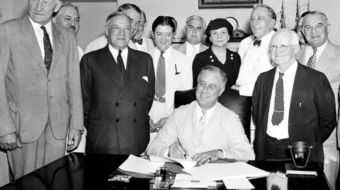Chemical board blames corporate cost-cutting
Agreeing with the Steelworkers union and strongly rejecting company claims of workers’ guilt, the federal government’s chemical safety investigations board threw the book at British Petroleum on Oct. 31 over the fatal explosion at its Texas City refinery more than a year ago.
In its preliminary report and recommendations to the Occupational Safety and Health Administration, the Chemical Safety Board said BP knew of hazards at the plant before the March 23, 2005, blast, which killed 15 workers and injured 180 other people. It said the firm didn’t fix the biggest hazards because it refused to spend the money.
“In 2004, BP’s own auditors found similar problems that were common across 35 units worldwide, including Texas City,” safety board chair Carolyn W. Merritt explained. “The findings describe the drastic effects of corporate cost-cutting at Texas City, where maintenance and infrastructure deteriorated over time.”
Steelworkers spokeswoman Lynne Baker wasn’t surprised by the findings.
“These voluntary protection programs in the refineries aren’t working,” she said of the Bush administration OSHA’s favored method for dealing with job safety and health issues, both in refineries and elsewhere. “It’s like the fox guarding the chicken house,” she continued. “Industry can’t police itself.”
Merritt’s five-person board was unanimous in its findings. Merritt said the explosion, and the reasons for it, should serve as a cautionary tale for oil and chemical companies and workers nationwide.
BP claimed that workers — members of the Steelworkers and formerly members of PACE and its predecessor, the Oil, Chemical and Atomic Workers — were responsible for the explosion in the Texas City refinery’s “blowdown drum,” part of its isomerization unit. USW sharply disagreed and challenged that conclusion, with its own investigation.
The chemical board found BP, not the workers, were at fault. Lead investigator Don Holmstrom reported “a distillation tower was overfilled with highly flammable hydrocarbons” which flowed down, and overflowed the drum. The drum had 58 valves. No valves “had undergone a required relief valve and piping study” to see if they could handle overfilling or other hazards, Merritt noted.
“Not only could the blowdown drum not hold enough liquid, it could not assure safe dispersion of flammable vapors through the vent stack,” Holmstrom said. And those conditions existed before the blast 18 months ago.
Before the drum exploded, Holmstrom said, it had eight releases of flammable vapors from 1994 to 2004. Six of the eight times, “ground-level vapor clouds” of hydrocarbons formed. Those would have produced explosions had a flame been present to set them off, he said. The other two times, the vent stack caught fire.
BP had 17 such blowdown drums at its refineries, including Texas City, and engineers recommended they all be removed as antiquated and possibly dangerous, he noted, to be replaced by a safer flare system. At Texas City “this was not done,” Holmstrom said. “Cost pressures drove this decision.”
Merritt also warned that other aging refineries in the U.S. are similarly at risk, a point Baker said USW emphasizes repeatedly. To prevent similar fatal explosions elsewhere, the board recommended OSHA warn companies “against using similar blowdown drums,” urge use of inherently safer flare systems, and ensure companies plan effectively for large-scale flammable liquid releases from process equipment.
It also called for “concerted inspection and enforcement” by OSHA at the plants.
— Press Associates Inc.









